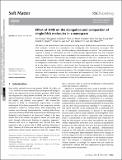| dc.contributor.author | Zhang, Ce | |
| dc.contributor.author | Guttula, Durgarao | |
| dc.contributor.author | Liu, Fan | |
| dc.contributor.author | Malar, Piravi P. | |
| dc.contributor.author | Ng, Siow Yee | |
| dc.contributor.author | Dai, Liang | |
| dc.contributor.author | van Kan, Jeroen A. | |
| dc.contributor.author | van der Maarel, Johan R. C. | |
| dc.contributor.author | Doyle, Patrick S | |
| dc.date.accessioned | 2017-03-15T19:36:24Z | |
| dc.date.available | 2017-03-15T19:36:24Z | |
| dc.date.issued | 2013-08 | |
| dc.date.submitted | 2013-05 | |
| dc.identifier.issn | 1744-683X | |
| dc.identifier.issn | 1744-6848 | |
| dc.identifier.uri | http://hdl.handle.net/1721.1/107424 | |
| dc.description.abstract | The effect of the bacterial heat-stable nucleoid-structuring protein (H-NS) on the conformation of single DNA molecules confined in a nanochannel was investigated with fluorescence microscopy. With increasing concentration of H-NS, the DNA molecules either elongate or contract. The conformational response is related to filamentation of H-NS on DNA through oligomerization and H-NS mediated bridging of distal DNA segments and is controlled by the concentration and ionic composition of the buffer. Confinement in a nanochannel also facilitates compaction of DNA into a condensed form for over-threshold concentrations of H-NS. Divalent ions such as magnesium facilitate but are not required for bridging nor condensation. The time scale of the collapse after exposure to H-NS was determined to be on the order of minutes, which is much shorter than the measured time required for filamentation of around one hour. We found that the effect of H-NS is not only related to its binding properties but also the confinement is of paramount importance. The interplay between confinement, H-NS-mediated attraction, and filamentation controls the conformation and compaction of DNA. This finding might have implications for gene silencing and chromosome organisation, because the cross-sectional dimensions of the channels are comparable to those of the bacterial nucleoid. | en_US |
| dc.description.sponsorship | Singapore-MIT Alliance for Research and Technology (SMART) | en_US |
| dc.description.sponsorship | National Science Foundation (U.S.) (Grant CBET-0852235) | en_US |
| dc.description.sponsorship | Singapore. Ministry of Education (Grants R-144-000-270-112 and R-144-000- 312-112) | en_US |
| dc.language.iso | en_US | |
| dc.publisher | Royal Society of Chemistry | en_US |
| dc.relation.isversionof | http://dx.doi.org/10.1039/c3sm51214b | en_US |
| dc.rights | Creative Commons Attribution-NonCommercial 3.0 Unported | en_US |
| dc.rights.uri | https://creativecommons.org/licenses/by-nc/3.0/ | en_US |
| dc.source | Royal Society of Chemistry | en_US |
| dc.title | Effect of H-NS on the elongation and compaction of single DNA molecules in a nanospace | en_US |
| dc.type | Article | en_US |
| dc.identifier.citation | Zhang, Ce et al. “Effect of H-NS on the Elongation and Compaction of Single DNA Molecules in a Nanospace.” Soft Matter 9.40 (2013): 9593. © 2013 Royal Society of Chemistry | en_US |
| dc.contributor.department | Massachusetts Institute of Technology. Department of Chemical Engineering | en_US |
| dc.contributor.mitauthor | Doyle, Patrick S | |
| dc.relation.journal | Soft Matter | en_US |
| dc.eprint.version | Final published version | en_US |
| dc.type.uri | http://purl.org/eprint/type/JournalArticle | en_US |
| eprint.status | http://purl.org/eprint/status/PeerReviewed | en_US |
| dspace.orderedauthors | Zhang, Ce; Guttula, Durgarao; Liu, Fan; Malar, Piravi P.; Ng, Siow Yee; Dai, Liang; Doyle, Patrick S.; van Kan, Jeroen A.; van der Maarel, Johan R. C. | en_US |
| dspace.embargo.terms | N | en_US |
| mit.license | PUBLISHER_CC | en_US |
